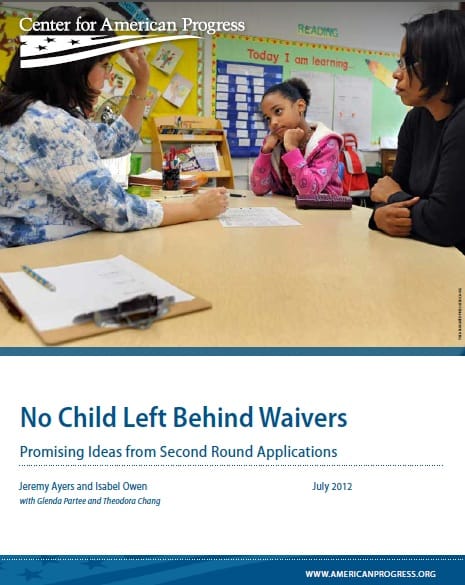 Better late than never. Jeremy Ayers and Isabel Owens of the Center for American Progress have now looked at the twenty-seven second-round waiver applications that states submitted to Secretary Duncan (as Ayers had done with the first round waivers in December 2011), seeking recurrent themes across three of the Department’s four priority areas: standards and assessments, accountability systems, and teaching and leadership. (“Duplication and burden” was not included as few states addressed it in their waiver applications.) Most importantly, they found that “the waiver process itself did not stimulate new innovations aside from accountability.” What’s more, even within this sphere, nine states opted to follow one of the Department’s prescribed options for accountability, and many others set similar goals, slightly tweaked—bringing into question the level of “innovation” that is actually occurring. (This is probably due to the feds’ tight leash on waivers at least as much to lack of imagination in the states.) CAP then uses its own policy priorities to rate the states’ applications and offer recommendations. Among them: The Department of Education should ask for more detail on aspects of state plans and should establish a clearinghouse to document and share tools, strategies, and lessons of implementation. There’s much helpful background here—and much detail about individual states’ waivers. But read with a discerning eye, remembering that CAP, during this election year, is not about to ding the Obama administration.
Better late than never. Jeremy Ayers and Isabel Owens of the Center for American Progress have now looked at the twenty-seven second-round waiver applications that states submitted to Secretary Duncan (as Ayers had done with the first round waivers in December 2011), seeking recurrent themes across three of the Department’s four priority areas: standards and assessments, accountability systems, and teaching and leadership. (“Duplication and burden” was not included as few states addressed it in their waiver applications.) Most importantly, they found that “the waiver process itself did not stimulate new innovations aside from accountability.” What’s more, even within this sphere, nine states opted to follow one of the Department’s prescribed options for accountability, and many others set similar goals, slightly tweaked—bringing into question the level of “innovation” that is actually occurring. (This is probably due to the feds’ tight leash on waivers at least as much to lack of imagination in the states.) CAP then uses its own policy priorities to rate the states’ applications and offer recommendations. Among them: The Department of Education should ask for more detail on aspects of state plans and should establish a clearinghouse to document and share tools, strategies, and lessons of implementation. There’s much helpful background here—and much detail about individual states’ waivers. But read with a discerning eye, remembering that CAP, during this election year, is not about to ding the Obama administration.
SOURCE: Jeremy Ayers and Isabel Owen, No Child Left Behind Waivers: Promising Ideas from Second Round Applications (Washington, D.C.: Center for American Progress, July 2012).
